|


| The Star & Garter was the town's main hotel, which
used to be in Victoria Street, where Pizza Hut now stands. It closed
in April 1961 and was demolished in about 1964 when the area was
redeveloped to make way for the Mander Centre. The building occupied
the site of a 16th century half-timbered house in which King Charles
I sheltered during the Civil War, and from this the hotel was named.
The hotel was re-built in 1836 in-character with the original
building. |
| In the 20th century the hotel was a popular place to
hold parties and special events and many dances were held there.
An advert from 1939 which gives an
impression of how the hotel looked at the time. |
 |
| The following photographs and hotel history are
from a booklet that was produced by the hotel in the mid 1920s. |
|

The restaurant. |
The historical associations of the original hotel
are deeply interesting. About 60 years ago the present Victoria
Street was better known as Cock Street, the name being altered to
Victoria Street after the visit to the town of Queen Victoria in
1866. On the site of the present handsome building was its ancient
predecessor, the Old Star & Garter Inn. This three-storied house, a
half-timbered building in the Elizabethan style of architecture, in
all probability dated its erection back to the dim ages of the
middle of the 16th century. |
| From a little distance, the view of the building
with its heavy-looking porch and red-tiled roof presented an
attractive and by no means an ungraceful appearance. On the
contrary, the very irregularities of its outline gave to it an air
of quiet and almost dignified purpose. The interior of the old
hostelry was quite as comfortable as its exterior was quaint and
inviting. On the ground floor, on one side of the entrance was a
commodious dining or general assembly room. On the other side was a
smoke room, and beyond the cosy little bar was a fair sized kitchen
or tap-room. |
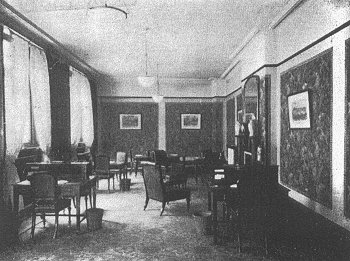
The writing room. |
|

The lounge. |
The rooms above were mostly sleeping chambers, with
one or two larger apartments on the second storey for the private
private accommodation of travellers. At the back of the inn was a
large yard, complete with stabling and all the necessary
conveniences of an old-fashioned house.
It
is open to question whether the Old Star and Garter could claim
to be, as has often been asserted, the oldest licensed house in
the town. However, in its favour it can be said that of all the
old taverns that have been swept away in recent years, by
successive improvement schemes, and of the few still remaining,
not one of them can compare with the Old Star and Garter in
regard to the historical and other interesting associations
connected with it.
Chief amongst these historical associations is that which links
it with the unfortunate King Charles the First.
|
|
Beneath its ancient roof King Charles sought temporary shelter
on his march from Shrewsbury to London, a few days before the
fierce battle between the Royalist Army and the Parliamentary
Forces in command of the Earl of Essex, at Edge Hill.
At that time, in 1642, the house was not a licensed inn, but the
private residence of a certain Madame St. Andrew, by whom His
Majesty was entertained. She was either sister or aunt to Mr.
Henry Gough, a wealthy merchant, to whom the property belonged.
Cock Street was then little better than a narrow, irregular
lane, bounded on either side with barns, fold-yards, and a few
scattered two-storied, red tiled dwelling houses and
straw-thatched cottages.
|

The front of the hotel. |
|
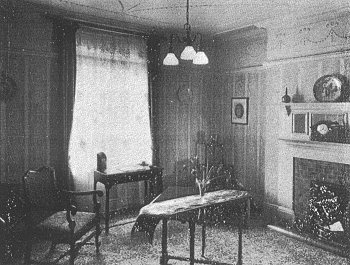
The drawing room. |
The only structures now remaining that can be supposed to have
been standing at the time of King Charles’s visit are the
half-timbered building at the bottom corner of John Street – and
which, it may be stated, is the only old dwelling-house in this
part of the country that presents in its construction the
‘herring-bone’ style of bricksetting – and the three low-browed
tenements on the opposite side.
To these, perhaps, may be added the ancient-looking shops nearer
to Queen Square and immediately facing these the old licensed
house known by the sign of the Spread Eagle. |
| In its palmy days, early in the eighteenth
century, the Old Star and Garter had a genial mirth-provoking host,
by the name, Paul Law. Born in 1799, and reared beneath the roof of
the old house that had afforded temporary shelter to the martyr King
of England. Young Paul, as he grew up, became a general favourite
with its frequenters. In the year 1818, Paul’s father John died and
Paul took, to a large extent, his late father’s place in assisting
his widowed mother in the management of the business. A few year’s
later, when his mother died, he became the landlord. |
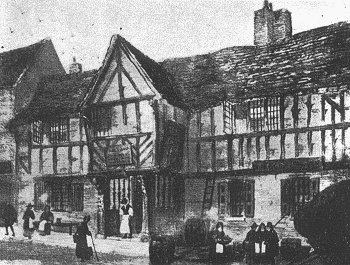
The old Star & Garter Inn. |
| From that period the fortunes of the house
gradually improved and the custom greatly increased.
Many happy stories are told to the pleasant, good-looking and
humorous young host, whose house was patronised by many of the
local squires and gentry. He drew around him a numerous, but at
the same time select circle of regular frequenters, real jovial
spirits like himself, who nightly made the old oak beams and
rafters ring with the hilarious laughter provoked by the
landlord’s quips and jokes, his racy anecdotes and smart
repartee.
The landlord, despite his easy, careless disposition was,
however, shrewd enough to observe that, regardless of the many
quaint and historical associations of the hostel, it was neither
sufficiently large nor attractive enough externally and
internally for modern requirements.
|
|
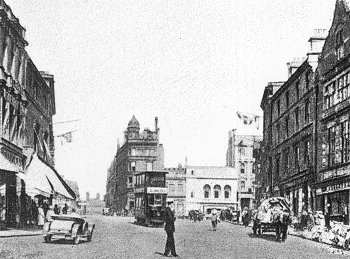
Queen Square. |
Desirous of keeping pace with the times, he interviewed the
owner, Mr. John Gough, and submitted to him a proposal for
pulling down the old premises and erecting on the site a hotel
of similar character, so far as the preservation of
the similar outlines was concerned, but of more extensive and
handsome proportions.
Mr. Gough, who took a kindly interest in the landlord, undertook
to execute the proposed alterations and improvements at his own
expense.
|
| In
the year 1834 the work of pulling down the old structure in portions
at a time, so as not to interfere unduly with the business
commenced. In October, 1836 it was brought to a successful
completion, the expenditure having amounted to over £7,000. One of
the apartments on the second floor, selected as occupying about the
same position as the one in the old house in which King Charles was
supposed to have slept, was named “The King’s Room”. It was never
allowed to be occupied, but was open for the inspection of visitors. |
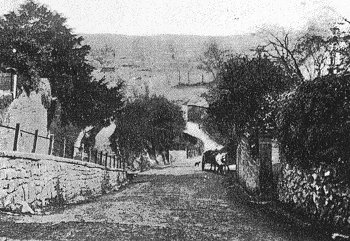
Compton Holloway. |
|
Paul Law was keenly desirous of preserving the historical
associations of the place, and he had this particular apartment
fitted up so as to represent the period of His Majesty’s Visit.
In the room was an old-fashioned canopied bed, but whether
it was, as was asserted, the same one on which the unhappy King
slept on the occasion of his visit, it is difficult to state. A
cabinet of carved, black oak, the chairs and other accessories
were all arranged “en-suite”, whilst the walls of the chamber
were adorned with pictures and oil paintings all having
references to the life of Charles I.
In November 1836, a house-warming dinner, to mark the re-opening
of the improved hotel was given, and was attended by a large and
representative gathering of the gentry and leading tradesmen of
the town.
In later years further additions and improvements have been
effected at the Star and Garter Inn, so that today it ranks as
one of the most attractive and comfortable commercial inns and
family hotels in Wolverhampton.

An advert from 1925.

|
 |
| Return to
the Services Hall |
|